Table of contents
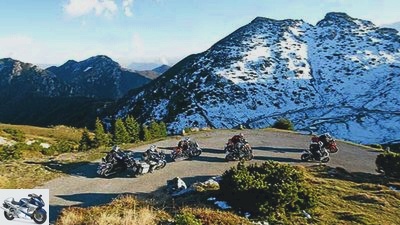
to travel
Proper motorcycling in a group
Ride a motorcycle in a group
Safe coexistence needs rules
A ride on a motorcycle should be sociable and safe, dynamic but relaxed. In order for this to work, everyone has to help.
Manuel Fuchs
04/11/2011
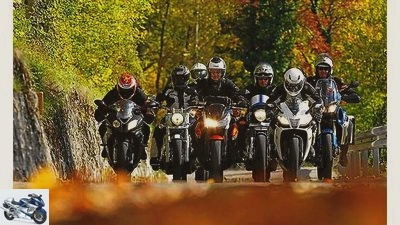
A clear case of “Not like that!” A wide juxtaposition that looks good on double-sided photos in motorcycle magazines is completely unsuitable for group trips.
The lonely biker on principle lives almost exclusively in cliche drawers. In the wild, one increasingly encounters small motorcycle groups, three to eleven vehicles, occasionally more. Joy shared is joy doubled, and in the best case only one of the group has to work with route planning.
That brings us to the first point: responsibility. The tour guide carries them to ensure that the group arrives back at the end of civilization or at least a suitable campsite, that horses and riders always have enough food and breaks on the way and that the route does not overwhelm anyone. The actual length of the stage is not even that important: On well-developed, possibly even well-known motorways, everyone probably drives 500 or more kilometers a day without exhausting them excessively.
At worst, you get bored into a coma. However, unknown, small, winding country roads can cost so much concentration and strength that the limit is already reached after 250 kilometers a day. And if you don’t concentrate, the fun is over quickly.
Anyone planning the route should bypass cities. The heavy traffic and the many traffic lights easily tear a group apart. Calling together again costs time and nerves. Often times, a short detour to the motorway turns out to be the more clever choice if a reasonable route outside is not feasible.
As much as you might wish, a group is never homogeneous. If you want to drive together, you have to be aware of the differences in the points “experience” and “Engine power” consciousness. To belittle them only leads to disappointment. Nothing helps: compromises have to be made.
That affects the basic pace, the stops, the route – and maybe even means that you separate for a few kilometers. At junctions or at a prominent point at the end of a stage that is particularly interesting from a driving point of view, you get together again.
Particularly thorough tour guides prepare a road book for each passenger, which includes a meeting point every 50 kilometers. That takes the pressure off of always keeping the person in front of you in sight. If you lose touch, simply drive to the next meeting at your comfortable pace.
When it comes to the order within the group, a mixture of experienced and less experienced pilots has proven to be effective. On the one hand, the latter can learn a lot from the driver in front, on the other hand, the experienced drivers can give their driver tips at the next stop and possibly even help to correct driving mistakes.
A mixed group also has it easier to compensate for surprising maneuvers by individuals. If all the experts and all newbies ride in their own group, there is a high risk that an unexpectedly slowing newcomer will drag some others away. A mixed group, however, requires that the faster drivers can and want to adapt to the common pace.
More motorized bikes tend to be at the bottom of the line. If the group overtakes another vehicle, the HP bolides can close the resulting gap with relative ease, even on confusing routes. However, the rider would have to be very demanding on a 34 hp motorcycle in order not to lose touch.
Although they all have one thing in common: Ultimately, everyone is responsible for themselves. For example, the fact that the man in front of me is about to overtake is not an invitation to follow him blindly. And not every cornering speed that he drives harmonizes with my motorcycle and my driving skills. Even if you feel strong in a group, a defensive and forward-looking driving style is essential. Not only for your own well-being, but also out of responsibility for those you are traveling with.
Staggered driving in a group
A staggered arrangement of the motorcycles in the lane brings a huge gain in safety. So everyone can assess the traffic situation for themselves and is not forced to react to the person in front of them. The next motorcycle driving diagonally ahead is decisive for the safety distance – not the next but one. If the worst comes to the worst, everyone has more space to swerve and brake.
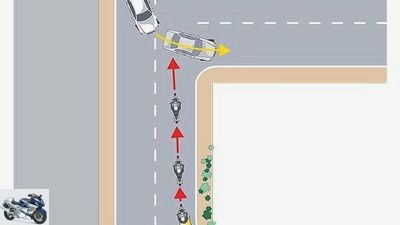
Driving in a group: wrong.
Anyone driving directly behind the vehicle in front of them can neither see the traffic situation nor the course of the curve sufficiently.
In addition, there is hardly any time to change lanes in the event of an emergency stop.
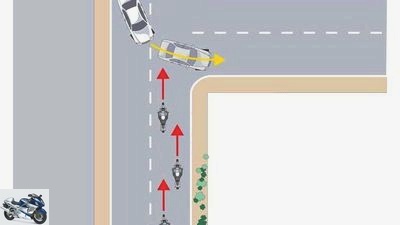
Driving in a group: correct.
Offset driving allows you to form your own judgment about the traffic situation and to react accordingly.
In addition, there is still the option of avoiding the vehicle in front in the event of a fall or emergency braking.
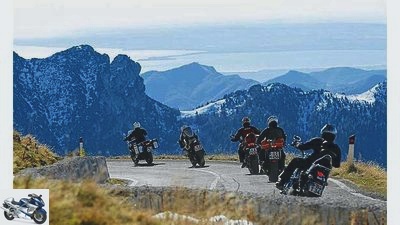
Curves: Swing is the most fun with a lot of space and without pressure. If you want to jostle, you’d better book a race training course.
Write road book: Anyone who prepares a tour takes notes anyway. Organizing and duplicating these is then only a small step, but a great help for all passengers.
Avoid cities: Even if they are considered valuable tourist destinations – from the motorcyclist’s point of view, they are primarily annoying. Especially when traffic and traffic lights tear the group apart.
Talk openly: If you feel overwhelmed, you have to say that; another hardly notices it. Even a driving style that is perceived as provocative or dangerous and other bad habits must be on the table – before it rattles.
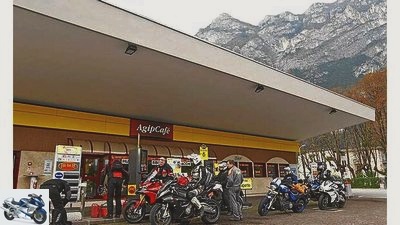
Refueling: The annoying compulsory exercise goes faster if all motorcycles are fed at a gas pump. One fills up, one keeps a record.
Refuel collected: All bikes swallow fuel from a column without the nozzle being attached. One of them notes the price displayed when a tank is full (“Andi 17.52 euros, Bodo 38.18 euros, Didi 52.03 euros”), pays and accounts after the tour. Use stops: stops are not pauses. While some refuel, others clean their visor, relieve their bladder or tar their lungs. Don’t let the hectic pace arise and don’t dawdle.
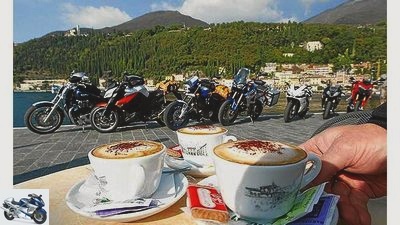
Breaks: Often enough, and then properly. A hastily dropped espresso hardly relaxes. Only real calm gives rise to strength
Use breaks: Consciously plan breaks, do not see them as an appendage to a refueling stop. Stop where it is nice, where there is something to see and where you can sit in peace.
Stay relaxed: Everyone has their own peculiarities: one looks three times in each rear-view mirror before driving off, another always needs two jugs of black tea to relax. Don’t get annoyed; we are out for fun, after all. But: bring up sources of danger.
Related articles
-
World record ride with an electric motorcycle
fact 15th pictures fact 1/15 How far can an electrically powered series motorcycle go in Drive 24 hours? The Zero S covered 1,316.88 kilometers. That is…
-
MOTORRAD travel podcast RIDE (episode 4): Motorcycle trip through South America
Podcast MOTORRAD RIDE episode 4 MOTORRAD travel podcast RIDE (episode 4): Motorcycle trip through South America MOTORRAD travel podcast RIDE (episode 4)…
-
Motorcycle travel magazine RIDE No. 06: Black Forest priority region
Tour tips Exclusive motorcycle tours for children to follow Presented by Dirk Schafer to travel Motorcycle travel magazine RIDE No. 06: Black Forest…
-
RIDE – exclusive motorcycle tours to download and descendants
Tour tips Exclusive motorcycle tours for children to follow Presented by Dirk Schafer to travel RIDE – exclusive motorcycle tours to download and…
-
Motorcycle travel magazine RIDE No. 05: Focus on Switzerland
Tour tips Exclusive motorcycle tours for children to follow Presented by to travel Motorcycle travel magazine RIDE No. 05: Focus on Switzerland…
-
Motorcycle tour tip Black Forest
Tour tips Exclusive motorcycle tours for children to follow Presented by MOTORCYCLE to travel Motorcycle tour tip Black Forest Motorcycle tour tip Black…
-
Motorcycle tours: The ten best routes in the Allgau
Photos: Daams 15th pictures Daams 1/15 The break at the roadside can be a little experience. Daams 2/15 Mountain cheese and buttermilk from our own…
-
Motorcycle tour Himalaya Ladakh
Photo: Lohse 32 pictures Lohse 1/32 Lohse 2/32 … must not rely on perfect conditions. But a lot can be mastered on the Enfield. Lohse 3/32 Lohse 4/32…
-
Zero Reader Test Ride 2020: Readers test Zero SR-F and SR-S
Volker Rost 20th pictures Volker Rost 1/20 Off to new shores: none of the participants has ridden such an electric motorcycle before. Volker Rost 2/20…
-
Ten short motorcycle tours in Germany
Rivas 32 pictures 1/32 Ten short trip destinations in Germany. 2/32 6. Franconian Alb; Route length: 170 kilometers. Schahl 3/32 The route starts in…